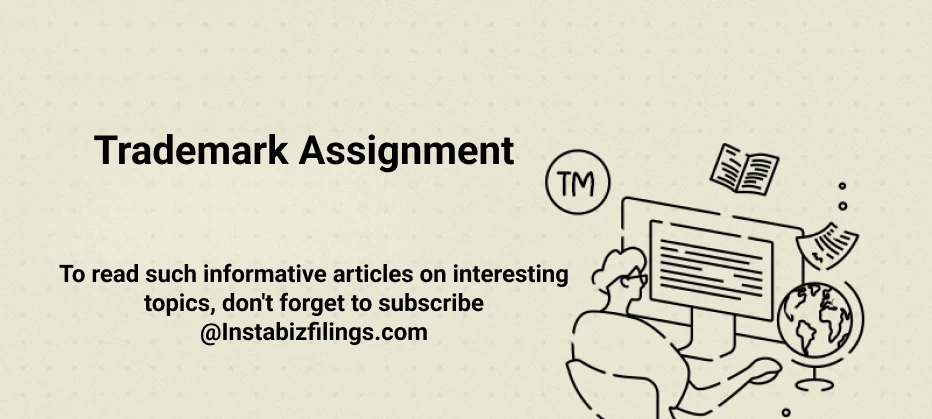
Trademark Assignment
October 14, 2025 by Team Instabizfilings
What is Trademark Assignment?
Trademarks assignment (or transfer). This is a legal procedure where the registration of a trademark owned by one party (assignor) is transferred to another party (assignee). Once it is assigned, the assignee becomes the registered holder and is allowed to exercise all rights, suing infringement, etc.
The assignment can or can not be made in goodwill (the reputation, clientele, brand value). When goodwill is added, then all the reputation attaching to the mark will pass; failure to add goodwill results in the transfer of the technical mark rights only.
It may be complete (all goods/services, full rights) or incomplete (only in particular classes, geographical areas or in particular goods/services).
Legal Framework & Key Statutes (as of 2025)
-
Trademarks Act, 1999
-
The Trademarks Rules, 2017
-
To seek registration of a subsequent proprietor in case of assignment or transfer of a registered trademark, the application is made using the form TM-P.
Under these rules:
-
The assignment must be written, either by deed or contract, upon which both parties (assignor and assignee) have signed it.
-
Permission should be registered with the Registrar by means of filing Form TM-P. The assignment cannot be assigned against third parties without recordal.
Types of Trademark Assignment
|
Type |
Description |
|
Complete Assignment |
The owner transfers all rights, including goods/services, full goodwill. |
|
Partial Assignment |
Only some classes, some goods/services, or certain territories. |
|
With Goodwill |
Includes business reputation, customer base, and value attached to brand. Important for brand continuity. |
|
Without Goodwill |
Only mark rights are transferred; the assignee may not inherit reputation tied to that usage. |
Additional variations:
-
Assignment for a part of India or certain regions.
-
Assignment among multiple assignees.
Documents & Requirements
Generally, to accomplish a legitimate transfer of the trademark in India, one would require the following:
-
Assignment Deed / Agreement: This is the contract between the assignor and the assignee and the terms of goodwill present or absent, scope (goods/services/classes) and date of assignment.
-
Power of Attorney (if someone else is filing on behalf)
-
Trademark Registration Certificate: to demonstrate the ownership of the mark in question.
-
Identity evidence and address of both parties (assignor and assignee) PAN Card, Aadhar Card, Passport etc.
-
A No Objection Certificate (NOC) may be required in some cases.
-
Form TM-P: properly signed and completed, and the deed.
If there is no assignment in good faith, it may impose other conditions, such as advertisements or directions by the Registrar in certain sections.
Process for Trademark Assignment (Step-by-Step)
-
Draft the Assignment Deed: Define assignor, assignee, goods/services, class(es), whether goodwill is included, and effective date.
-
Obtain Necessary Signatures & POA: Both should sign, where there is an agent, POA or power of the same.
-
Complete Form TM-P: Enter information about the number of trademark registrations, class, assignor, assignee, date of assignment etc.
-
Attach Supporting Documents: Deed, registration certificate, identity proofs etc.
-
Recurring Fee to Government, depending on the class and the mode of filing (online or physical).
-
Submit to Trademark Office: File TM-P via IP India portal, or physically (if allowed, though digital is preferred)
-
Examination by Registrar: Registrar reviews the documents. They may ask for clarifications or documents.
-
Recordal / Certificate of Registration: When all is well, the Registrar makes changes in the trademark register and the new owner is designated through a Certificate. The assignee is legally recognised as the owner.
-
Public Notice / Advertisement (where necessary by certain sections, particularly in the disposal without goodwill)
Fees, Timeline & Other Practical Aspects
|
Aspect |
Details |
|
Official Fee (TM-P) |
For the assignment of a registered trademark, the fee is ₹10,000 per trademark per class if filed physically; ₹9,000 for e-filing. |
|
Fees for Other Scenarios |
Sometimes, reduced fees or different fee slabs for “without goodwill” assignments or smaller entities (e.g. individuals, startups, small enterprises). |
|
Timeline |
Normally takes a few months (often 3-6 months) depending on the clarity of documents, backlog at the Registry, and whether objections or additional advertisement are needed. |
|
Late Recordal |
There is a prescribed window for filing an assignment after the acquisition of proprietorship; delays may attract additional formalities. |
Key Considerations & Pitfalls
-
Goodwill Transfer: This may cause confusion or legal challenge in the future, in case goodwill is not transferred where it ought to have been transferred. Indeed, always clearly specify.
-
Partial Assignment Complexity: In the case where the assignor still maintains rights in part of the classes or part of the geographical location, clearance is necessary in the deed to eliminate overlaps in rights.
-
Territorial Use: Sometimes assignments are restricted to certain regions; make sure the scope is precise.
-
Objections / Oppositions: Assignment can be advertised (notwithstanding the absence of goodwill) and is open to objections by third parties. Be prepared.
-
Proof of Ownership: The assignor has to possess a clear record showing that he/she owns the mark.
-
Timeliness: It is not problematic as filing TM-P should occur within a reasonable time.
-
Proper Stamp / Stamp Duty: The assignment deed may require stamp duty depending on the state; check local rules.
Recent or Emerging Trends in 2025
-
The push of IP India to make online filings and digital recordals so as to minimise the delays.
-
Greater examination of assignments that are not in good faith. The Registry takes pains not to misuse or be confused.
-
Additional emphasis on checking the identification of assignees, address verification etc.
-
Faster processing in many jurisdictions due to digitisation, but still delays are possible if the documentation is not complete.
Sample Use-Cases
-
Business Sale / Merger: In case a startup is sold, the trademarks can be sold to the buyer.
-
Divestment A company gives up one product line and the trademark applicable to that line is transferred to the purchaser.
-
Licensing vs Assignment: There are cases where a full assignment can be desirable as opposed to licensing, in case it is desirable to have permanent ownership transfer.
-
Strategic Rebranding: The transfer of trademarks of the old entity to the new entity, or in the case of reorganisation.
Pros & Cons
|
Pros |
Cons |
|
Legal clarity of ownership after transfer |
Costs involved in legal, stamp duty, fees |
|
Enables monetisation or sale of brand value |
If done poorly, it might lead to disputes |
|
Helps in business restructuring or mergers |
Partial or ambiguous deeds can cause overlapping rights |
|
Allows assignee to fully enforce infringement rights |
Delay or failure to record an assignment can weaken legal standing |
Trademark Assignment vs Transmission & Other Related Concepts
-
Transmission: Occurs through law (e.g death of owner, insolvency). Not by contract. Assignment is by contract.
-
Licensing: Granting permission to use a trademark, without transferring ownership.
-
Registered User: A person who is allowed to use a registered trademark under some conditions, but ownership remains with the proprietor.
The reason as to why these differences are essential is that rights, obligations and legal outcomes are different.
Conclusion
The trademark assignments play a critical role in the management of your intellectual property brand contested particularly during the sale, restructuring, licensing or change of ownership.
In the case of 2025, where the regulatory focus is on digital processes and recordal, it is more significant than ever to make sure that assignments are documented appropriately, performed correctly, and that records are timely to file with Form TM-P.
Seeking professional assistance (lawyers or agents with the area of IP specialisation) can also prevent the pitfalls often encountered, accelerate the process and guarantee that you do not lose the right to file a lawsuit against the infringement of your intellectual property.
Disclaimer
The information provided in this blog is purely for general informational purposes only. While every effort has been made to ensure the accuracy, reliability and completeness of the content presented, we make no representations or warranties of any kind, express or implied, for the same.
We expressly disclaim any and all liability for any loss, damage or injury arising from or in connection with the use of or reliance on this information. This includes, but is not limited to, any direct, indirect, incidental, consequential or punitive damage.
Further, we reserve the right to make changes to the content at any time without prior notice. For specific advice tailored to your situation, we request you to get in touch with us.


